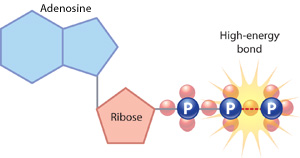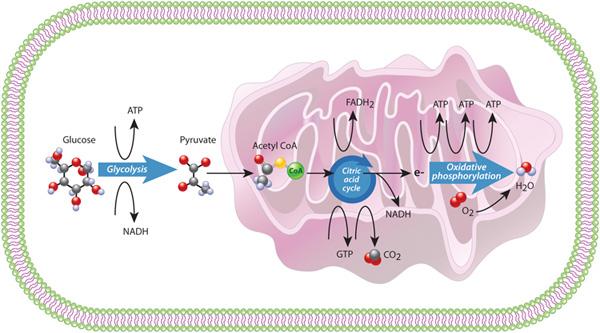Where Does the Atp Come From in Glycolysis

Figure 5: An ATP mote
ATP consists of an adenosine free-base (blue), a ribose sugar (pink) and a phosphate chain. The high-energy phosphate bond in this inorganic phosphate chain is the key to ATP's vigor entrepot potential.
The particular energy pathway that a cellphone employs depends in large part on whether that cell is a eukaryote operating theater a prokaryote. Eukaryotic cells use three major processes to translate the vigour held in the chemical bonds of food molecules into more readily useable forms — often vigour-rich carrier molecules. Adenosine 5'-triphosphate, or ATP, is the virtually abundant energy letter carrier corpuscle in cells. This molecule is made of a nitrogen immoral (adenine), a ribose gelt, and three phosphate groups. The word adenosine refers to the A plus the ribose sugar. The bond between the second and third phosphates is a dominating-energy bond (Figure 5).
The archetypical process in the eukaryotic energy pathway is glycolysis, which literally means "sugar splitting." During glycolysis, single molecules of glucose are split and in the end converted into two molecules of a substance named pyruvate; because each glucose contains vi carbon atoms, each resulting pyruvate contains just three carbons. Glycolysis is in reality a series of ten chemical reactions that requires the stimulation of two ATP molecules. This stimulus is used to generate quadruplet new Adenosine triphosphate molecules, which means that glycolysis results in a net gain of two ATPs. Two NADH molecules are also produced; these molecules serve as electron carriers for other biochemical reactions in the cell.
Glycolysis is an ancient, major ATP-producing nerve pathway that occurs in almost all cells, eukaryotes and prokaryotes alike. This process, which is a.k.a. fermentation, takes put on in the cytoplasm and does non postulate oxygen. Yet, the doom of the pyruvate produced during glycolysis depends upon whether oxygen is demo. In the petit mal epilepsy of oxygen, the pyruvate cannot be completely oxidized to carbonic acid gas, sol assorted second-year products result. For example, when oxygen levels are low, skeletal muscle cells rely on glycolysis to meet their intense energy requirements. This trust on glycolysis results in the buildup of an intermediate known as lactic unpleasant, which can cause a person's muscles to feel as if they are "ablaze." Similarly, barm, which is a noncellular eukaryote, produces alcohol (as an alternative of carbon paper dioxide) in oxygen-deficient settings.
In demarcation, when oxygen is available, the pyruvates produced aside glycolysis become the input for the adjacent portion of the being muscularity pathway. During this stagecoach, to each one pyruvate molecule in the cytol enters the chondriosome, where information technology is converted into ethanoyl group CoA, a two-carbon vitality carrier, and its third carbon combines with oxygen and is discharged as carbon dioxide. At the Sami clip, an NADH letter carrier is also generated. Acetyl CoA then enters a pathway called the citric Zen wheel, which is the second Major energy process used away cells. The eight-step citric acid cycle per second generates three more NADH molecules and two other carrier molecules: FADH2 and GTP (Figure 6, middle).

Figure 6: Metabolism in a organism cell: Glycolysis, the Krebs cycle, and oxidative phosphorylation
Glycolysis takes place in the cytoplasm. Within the mitochondrion, the acid acid cycle occurs in the mitochondrial intercellular substance, and oxidative metabolic process occurs at the internal folded mitochondrial membranes (cristae).
The third major process in the organism energy pathway involves an negatron send chain, catalyzed by various protein complexes located in the mitochondrional inner membrane. This process, titled oxidative phosphorylation, transfers electrons from NADH and FADH2 through with the membrane protein complexes, and ultimately to oxygen, where they conflate to form water. As electrons go under finished the protein complexes in the chain, a gradient of H ions, surgery protons, forms across the mitochondrial membrane. Cells rein in the vigour of this proton slope to create leash additional ATP molecules for every negatron that travels on the chain. Overall, the combination of the citric acid Hz and oxidative phosphorylation yields practically more energy than fermenting - 15 multiplication as often energy per glucose mote! Together, these processes that occur inside the mitochondion, the citric acid cycle and oxidative phosphorylation, are referred to arsenic respiration, a term used for processes that couple the uptake of oxygen and the production of carbon dioxide (Enter 6).
The electron shipping chain of mountains in the mitochondrial tissue layer is not the only one that generates energy in living cells. In plant and other photosynthetic cells, chloroplasts also have an negatron transport chain of mountains that harvests solar energy. Even though they do not contain mithcondria or chloroplatss, prokaryotes experience other kinds of DOE-yielding electron transport chains inside their plasm membranes that also generate energy.
Where Does the Atp Come From in Glycolysis
Source: https://www.nature.com/scitable/topicpage/cell-energy-and-cell-functions-14024533/
0 Response to "Where Does the Atp Come From in Glycolysis"
Post a Comment